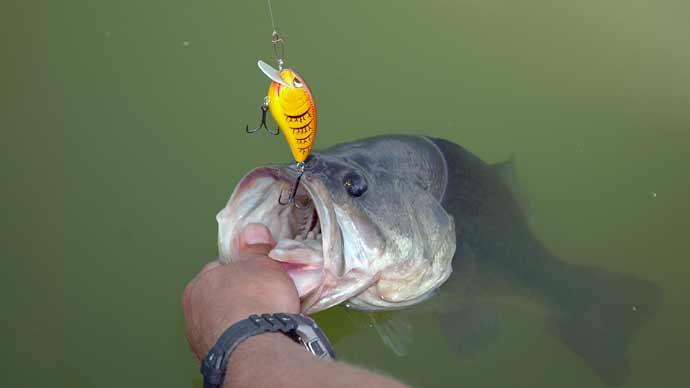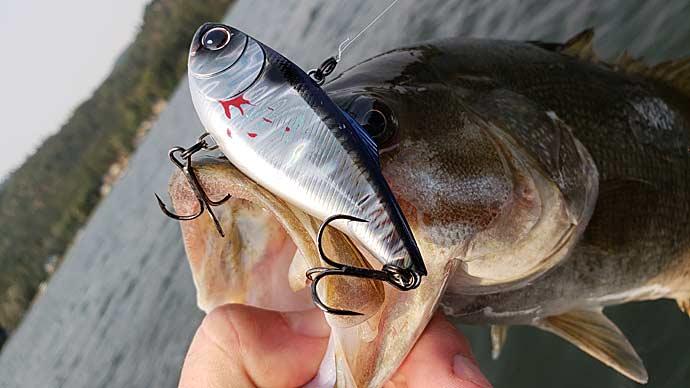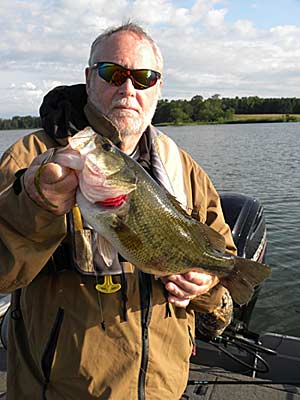
One of the most challenging times to put bass in the boat can be Springtime. Are they shallow or deep or somewhere in between? To go with that, what is your go-to bait for this time of the year? I often get out my crankbait box, grab a square bill, and go to work. We had a few warm weeks under our belts, so some bass should start moving towards the shallows. This is time to get on the trolling motor and cover water, looking for that first bass contact, making their trek shallower.
Let's break down Spring square bill tactics to help you put more bass in your boat this season.
Rods/Reel Breakdown
Regarding rods and reels, I carry a few different setups to match the conditions in which I’m fishing. If I’m fishing open water looking for signs of bass, I’ll use a 7’10” Denali Lithium Pro baitcaster rod (LP7105XD) that is teamed with a Denali Novus Pro (6.2:1) baitcasting reel. This is spooled with Sunline Crank FC 10lb test. I am making long casts and getting my bait down as deep as possible. I’ll also have a second rod rigged with the same reel setup, but I will have this reel spooled with 12lb Sunline Crank FC. When I’m fishing in weeds, I will upsize my line.
I aim to make a long cast, reel the bait down, and try to contact the tops of the weeds or the cover as I bring my square bill back to the boat. The more contact I can make with the weeds/cover, the more strikes I will create. If I hit weeds, I’ll act like I'm setting the hook to break the bait free and on its way again. I will bring it in, clean it off, and make another cast if it gets fouled. The more cover I can come in contact with and break my bait free, the better my chances of triggering a strike.
If I am fishing shallower around targets, I’ll switch to a 7ft Denali Lithium Pro baitcaster rod (LP703CB) that is teamed with a Denali Novus Pro baitcasting reel this is spooled with 12lb Sunline Crank FC. The main reason for the shorter rod choice comes down to one thing: better casting control. It is easier to underhand roll cast with the 7' rod than the 7’10” rod.
Square Bill Breakdown
There are a lot of square bills on the market today. Here are a few lessons I have learned through the years about how to fill your box with baits that will put bass in your boat.
Color
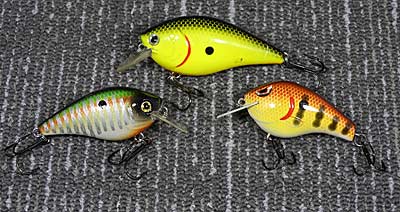
When it comes to the color of the baits that I stock in my square bill box, it is not random; it is well thought out. I’ll stock colors of the top forage in my area. Bluegill, craws, and perch are my top colors. I’ll also stock a few shad colors if I head to the river. These colors of choice are for clear water situations. I will also add another round of these forage colors, but I’ll look for baits that have accent colors. I’m looking for colors that will be found in dirty water conditions. I will also add a few bright colors to my box to throw in cover where bass can get a passing glimpse and make a run at the bait.
Sound
Sound can sometimes be a factor; I stock square bills with rattles and some without. I am a fan of looking at multiple brands of baits for this because one company’s sound may differ from the next. Try to put a few baits from each other in your box. I stock 3 or 4 assorted brands to get a variety of choices in my box. I have had situations where the bass preferred one brand over others that day. On certain days, this can make a substantial difference in filling the live well or struggling to generate bites. I also stock silent baits in my box as well. Some days, sound is critical, while on other days, silent bait is preferred.

Another tweak I’ll make is to change all my hooks to Gamakatsu short shank wide gap hooks. These hooks are sticky sharp right out of the package, and once a bass gets hooked, they have a tough time getting off. I have seen my landing number rise at a sizeable rate after this Gamakatsu hook change was made. Also, pay attention to your hooks during your day on the water. Please take a few seconds to check them daily to ensure your hooks are still sticky sharp. If you have a hook that needs attention, take a few minutes to touch up the points on that hook. It will result in more bass over the side of your boat during your day of fishing.
Size Matters
Many companies offer square bills in two sizes. Stock a few varied sizes of each in your box. I have had days when bass prefer one size over the other. I adjust my size choice according to the season. Early in the season, I’ll fish a smaller bait to match the forage in the water. As the season goes on, I’ll often switch to the larger size again, matching the forge size swimming in the waters at that time.
Cover
Cover will be mainly divided into two categories early in the season: weeds and rocks. Bass will use both types of structures to facilitate their food needs. As craws become more active with the warming water conditions, bass will be drawn to rock areas, and so will other bait sources. As the shallower water warms, baitfish and bass will be drawn shallower, where weeds will come into the mix.
Rocks
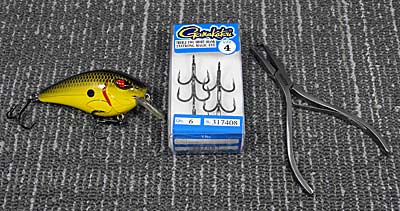
When fishing rock areas, make sure that your square bills contact the rocks during your retrieve if possible. The deflection action off the rocks will trigger strikes. If you cannot make contact with the rocks, one of my tactics is to crank my bait down and use a stop-and-go retrieve. Now and then, I will stop reeling and give the bait a 1,2, 3 count and start to reel again. It's been my go-to triggering factor when I can’t get my bait deep enough to contact the cover. Stopping the bait or changing the direction of my bait will also create bites.
Change directions when fishing rocks. Make a few casts in one direction, then take a different angle and make a few casts. If you can figure out an edge factor, use it, as the bass will do the same. This edge is where shallower or deeper weeds start; make sure you fish these edges.
Weeds
Weeds are another source of cover to target. Bass use weeds as they move into the shallows. Early-season weeds can be at various stages. The better you pay attention to this, the more success you will have. Head towards deeper water, where the bass will come from, to move shallower as the water warms. Look for thicker weeds; these are the areas that the bass will set up in and will return to if they are faced with a few days of cold front conditions that move in. When needed, they will use these thicker weed areas as a home base and move out as the waters warm.
I hope the basis that I set out here will help you get prepared better to put more bass in your boat with square bills this season. Square bills can not only catch bass in the Spring; they are a force all season long when given a chance.


